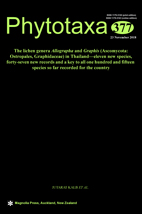Abstract
We provide an updated account on the genera Graphis s.str. and Allographa (formerly included in Graphis) from Thailand. Four species of Allographa are described as new to science, viz. A. atrocelatoides, which differs from A. atrocelata in having marginata-morph lirellae and a smooth, off-white to beige thallus; A. kansriana, which differs from A. aquilonia in having negrosina-morph lirellae and brownish ascospores; A. schummii, which is characterized in having large, muriform ascospores and an open disc with a cinnabar-red pruina, reacting K+ lemon yellow; and A. sitianoides, which differs from A. sitiana in having immersed to erumpent lirellae and longer ascospores with more numerous septa. Twenty-seven further species are being recombined in the genus Allographa, viz A. acharii, A. aquilonia, A. atrocelata, A. elongata, A. hossei, A. leptospora, A. lumbricina, A. macella, A. marginata, A. norvestitoides, A. nuda, A. pavoniana, A. phaeospora, A. rhizicola, A. rimulosa, A. rufopallida, A. rustica, A. sauroidea, A. seminuda, A. semirigida, A. striatula, A. subdisserpens, A. subdussii, A. trichospora, A. verminosa, A. vestitoides, and A. xanthospora. Seven new Graphis species are described, viz. G. albocarpa, which differs from G. glaucescens in having a laterally to completely carbonized exciple, larger ascospores, and a norstictic acid chemistry; G. emersella, which differs from G. emersa in having hossei-morph lirellae and smaller ascospores with fewer septa; G. khaojoneana, which differs from G. bungartzii in having immersed, unbranched lirellae and smaller ascospores with fewer septa; G. omiana, which differs from G. luluensis in having larger ascospores with more numerous septa and a more complex chemistry relating to the stictic acid aggregate; G. schummiana, which differs from G. anfractuosa in having a laterally to completely carbonized exciple and in the reddish brown pruinose, K+ purple disc; G. sublitoralis, which differs from G. litoralis in having scripta-morph lirellae and in lacking protocetraric acid; and G. subschroederi, which differs from G. schroederi in having smaller ascospores and a laterally carbonized exciple. Four new lirellae morphs are defined, viz. filiformis-morph, balaghatensis-morph, leptogramma-morph and schummiana-morph. After several collecting trips to nineteen provinces of the country, further forty-seven new records of the two genera are added to the most recent checklist of Thai lichens. A key is given to all Allographa and Graphis species so far known for Thailand, as well as close-up photographs of the newly described or newly reported species. The following ten names are removed from the most recent Thai checklist: Graphis concolor ≡ Diorygma junghuhnii, G. fissurinoidea = Diorygma confluens, G. glaucocinerea = Graphis aphanes, G. glaucorufa = Allographa rufopallida, G. irosina = Acanthothecis dialeuca, G. longispora = G. koratensis, Graphis nuda (probably a misidentification), G. ochrocheila ≡ Dyplolabia ochrocheila, G. persimilis = Phaeographis hypoglauca, and G. subrigida = Platygramme platyloma. Graphis siamensis does not belong in this genus but is likely a species of Phlyctis. Graphis diplocheila has a clear hymenium and is a younger synonym of G. streblocarpa and G. dracaenae produces norstictic acid and must therefore kept apart from G. geraensis.

